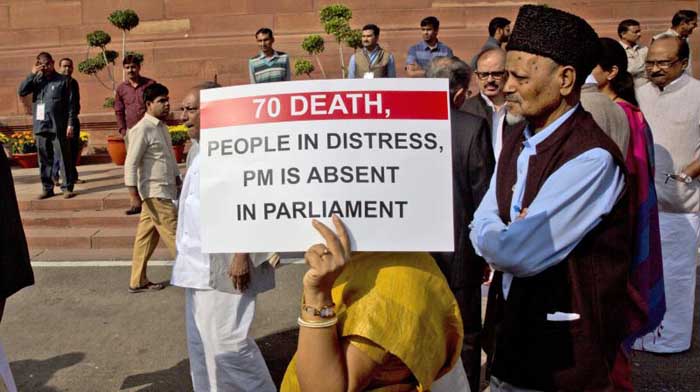A Theoretical Critique of Demonetisation

NEW DELHI: There has been a lot written on demonetisation, but detailed Western arguments have rarely been consulted. Kenneth Rogoff, a well known American economist provides a clear and critical Western perspective. Like other foreign economists Professor Rogoff points out that even at this stage the Government of India hasn't "finished printing all the currency, and its scarcity is being felt."
This sentence is euphemistic. With 86% of currency demonetised, there is a lot of currency to be printed. The loss of cash is still impacting on the Indian economy, especially on the lower and middle strata. Despite earlier promises of a return to normalcy after 50 days, the Prime Minister Narendra Modi asked for more, unspecified time.
Prof. Rogoff writes "demonetisation recommends five to seven years to phase a particular currency. It also says demonetisation is not such a good idea for developing economies." He later reiterates "if you are a developing economy. This (demonetisation) really not something for you." So what does the government need to do to remonetise India?
Prof. Rogoff answers: "Very simply, you have to finish printing the cash so that people can pay workers and suppliers. In the long run, other goals of the demonetisation, such as fighting corruption, black money, and terror funding can be worked on in other days."
About the autonomy of the Reserve Bank of India, Prof. Rogoff stresses that "the central bank's independence is something you have to fight for every day." This is an important lesson for India. Prof. Rogoff also unpacked demonetisation, removing corruption, black money and terrorist funding from the onerous job of rapidly printing cash to increase liquidity in the economy. He also pointed out that "countries should get rid of only large denomination notes. But you didn't have anything large; your largest was $15."
Why is demonetisation bad for a developing economy? As numerous economists from the West like Larry Summers, former President of Harvard University; Kaushik Basu, Chief Economist of the World Bank; and Prof. Amartya Sen, Nobel Laureate in Economics, have pointed out, in a largely cash based economy like India, demonetisation especially a severe one of 86% is a recipe for an economic disaster.
Further, the planning was very poor and haphazard. The ₹2000 note was being printed only two months before November 8, 2016. The ₹500 currency note which was more than 45% of the total currency was printed a couple of weeks before the note ban. This highly belated printing of currency notes led to the massive cash crunch, which hit the economy very hard. Before demonetisation India was growing at 7.6% of GDP. By January 2017, the IMF estimated that GDP growth had dropped to 6.6%, within a period of just two months.
The GoI was very slow in remonetisation of the economy. It imported only 8000 metric tonnes of currency paper for the printing of currency notes in 2016. In 2017 it imported 27,500 metric tonnes for currency paper from eight foreign companies. Without adequate currency paper there could be no printing of notes. So further delay in remonetisation, greater loss of potential cash flows, hit the economy hard. It continues to be facing a severe cash crunch, which will further dampen possibilities of economic growth.
Demonetisation was claimed to be necessary to expose black money. But it is estimated by economists to amount to only 5-7% of the total cash in the economy. Black assets are mainly in real estate, gold, jewellery, shares, etc. Further, a significant proportion are kept in tax havens like the Cayman Islands, Dubai, the Virgin Islands, Singapore, etc. Curiously to demonetise the ₹1,000 and ₹500 currency notes to stop black money, the Modi government introduced an even larger ₹2,000 currency note. This would be a greater "black" money note as it would be 100% greater than the ₹1,000 note.
It was also stated by PM Modi, that the ₹1,000 and ₹500 currency notes were likely to be used by terrorists. But the recent terrorist attack in Nagrota revealed that the terrorists had the new Indian currency including ₹2000 currency notes. So this argument does not hold. It was argued that the note ban would hit corruption hard. That too has not happened. So as numerous economists in India and abroad have pointed out there appears to be no causal link between high end currency notes and corruption.
The real reasons appear to be political. Speaking at midnight of November 8, 2016 PM Modi lashed out at the 70 years post Independence of accumulated black money, corruption and its negative impact on terrorism. He repeated it in his Goa speech at the end of the month, where he asked for 50 days to put the economy back in order. His Attorney General spoke of 70 years of "slush" money to the Supreme Court. In the first place, August 1947+70 years=August 2017, which is still to arrive. More seriously, PM Modi came into office in mid-2014. So according to his own arithmetic PM Modi, is part of the corrupt, anti-people years.
More shocking is Modi's complete sidelining of the Sangh parivar, including leaders like Shyama Prasad Mookerjee, founder of the Bharatiya Jana Sangh; Atal Bihari Vajpayee; and L.K. Advani among others. So the PM's gambit was also largely political. Thus the hasty and untenable demonetisation. The people are suffering, the economy is down as a consequence of bad planning, poor implementation and partisan politics.
(Kamal Mitra Chenoy is a Professor at Jawaharlal Nehru University)



